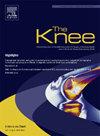膝关节脱位及多发韧带损伤中内侧韧带断裂的病理解剖。
IF 1.6
4区 医学
Q3 ORTHOPEDICS
引用次数: 0
摘要
目的:描述伴有内侧受累的急性mlki的内侧病理解剖和韧带损伤,并根据韧带损伤的位置寻找相关的损伤模式。方法:选取2001年1月至2023年5月在两个一级创伤中心接受MLKI治疗的患者。我们只包括了涉及浅内侧副韧带(sMCL)完全断裂的病例。记录sMCL、后斜韧带(POL)、髌股内侧韧带(MPFL)、股内侧斜肌(VMO)的损伤区域,以及人口统计学、损伤细节、神经血管状况和损伤机制。数据采用描述性统计进行汇总。结果:共纳入92例患者,平均年龄37.8±12.7岁。44例(47.8%)为高速损伤。在sMCL撕裂中,39%为近端撕脱,29%为中端撕脱,32%为远端撕脱。内侧损伤类型为:单纯sMCL撕裂31例(33.7%),sMCL、POL和MPFL联合撕裂24例(27.3%),sMCL和MPFL联合撕裂23例(25%),sMCL和POL联合撕裂11例(12%)。最常见的sMCL损伤位置因相关膝关节内侧韧带损伤的数量而异:孤立性sMCL(均匀分布)、sMCL & POL(远端)、sMCL- mpfl(近端)、sMCL-POL- mpfl(近端)。结论:内侧韧带损伤可发生在四种损伤类型中,包括单纯性小韧带损伤或相邻内侧结构的联合损伤。此外,sMCL损伤的位置根据内侧韧带损伤的数量而变化。本文章由计算机程序翻译,如有差异,请以英文原文为准。
The pathoanatomy of medial ligamentous disruption in the dislocated and multiple ligament injured knee
Purpose
To describe the medial-sided pathoanatomy and ligament injuries in acute MLKIs with medial-sided involvement and look for associated injury patterns based upon location of ligamentous injury.
Methods
Patients who underwent treatment for MLKI at two level-1 trauma centers were identified between January 2001 and May 2023. Only cases involving complete disruption of the superficial medial collateral ligament (sMCL) were included. Zone of injury to the sMCL, the posterior oblique ligament (POL), the medial patellofemoral ligament (MPFL), the vastus medialis oblique (VMO) was recorded, as well as demographics, injury details, neurovascular status, and mechanism of injury. Data was summarized using descriptive statistics.
Results
A total of 92 patients were included, with a mean age of 37.8 ± 12.7 years. Forty-four (47.8%) patients had a high velocity injury. Within sMCL tears, 39% were proximal avulsions, 29% were midsubstance tears, and 32% were distal avulsions. The medial-sided injury patterns were: 31 (33.7%) isolated sMCL tears, 24 (27.3%) combined sMCL, POL, and MPFL tears, 23 (25%) combined sMCL and MPFL tears, and 11 (12%) combined sMCL and POL tears. Most common location of sMCL injury varied based upon the number of associated medial knee ligaments injured: isolated sMCL (even distribution), sMCL & POL (distal), sMCL-MPFL (proximal), sMCL-POL-MPFL (proximal).
Conclusion
Medial-sided ligament injuries seen MLKIs were found to occur in four injury patterns ranging from isolated sMCL or combined injury patterns of the adjacent medial structures. Additionally, location of sMCL injury varied based upon the number of medial-sided ligaments injured.
求助全文
通过发布文献求助,成功后即可免费获取论文全文。
去求助
来源期刊

Knee
医学-外科
CiteScore
3.80
自引率
5.30%
发文量
171
审稿时长
6 months
期刊介绍:
The Knee is an international journal publishing studies on the clinical treatment and fundamental biomechanical characteristics of this joint. The aim of the journal is to provide a vehicle relevant to surgeons, biomedical engineers, imaging specialists, materials scientists, rehabilitation personnel and all those with an interest in the knee.
The topics covered include, but are not limited to:
• Anatomy, physiology, morphology and biochemistry;
• Biomechanical studies;
• Advances in the development of prosthetic, orthotic and augmentation devices;
• Imaging and diagnostic techniques;
• Pathology;
• Trauma;
• Surgery;
• Rehabilitation.
 求助内容:
求助内容: 应助结果提醒方式:
应助结果提醒方式:


